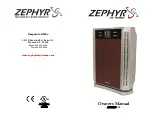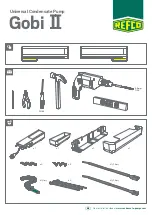
:
Manufacturer reserves the right to change, at any time, specifications and designs without notice and without obligations.
13
HEATING Mode
Compressor Control
1. Reach the configured temperature:
•
If the following conditions are satisfied, the compressor
ceases
operation.
a.
While the calculated frequency (fb) is less than the minimum
limit frequency (FminC).
b.
When the protective time is more than or equal to ten
minutes.
c.
When T1 is higher than or equal to Tsc+HDIFTEMP2.
NOTE: HDIFTEMP2 is the EEPROM setting parameter. It is 4
F
(2
C) usually.
•
If the following conditions are satisfied, regardless of time.
a.
Compressor running frequency is more than test frequency.
b.
When the compressor running frequency is equal to the test
frequency, T4 is more than 59
F (15
C) or no T4 or
T4 fault.
c.
Change the setting temperature.
d.
Turbo or sleep function on or off.
2. When the current is higher than the predefined safe value, the surge
protection is activated, causing the compressor to cease
operations.
Indoor Fan Control
1. In the
HEATING
mode, the indoor fan operates continuously. The
fan speed can be set to 1%
−
100%, or muted.
2.
AUTO
fan
•
Rise curve
a.
When T1
−
Tsc is higher than
−
2.7
F (-1.5
C), fan
speed
reduces to 80%;
b.
When T1
−
Tsc is higher than 0
F (0
C), fan speed
reduces to
60%;
c.
When T1
−
Tsc is higher than 0.9
F (0.5
C), fan speed
reduces
to 40%;
d.
When T1
−
Tsc is higher than 1.8
F (1
C), fan speed
reduces
to 20%.
•
Descent curve
a.
When T1
−
Tsc is lower than or equal to 0.9
F (0.5
C),
fan
speed increases to 20%;
b.
When T1
−
Tsc is lower than or equal to 0
F (0
C),
fan speed
increases to 60%;
c.
When T1
−
Tsc is lower than or equal to
−
2.7
F (
−
1.5
C), fan
speed increases to 80%;
d.
When T1
−
Tsc is lower than or equal to
−
5.4
F (
−
3
C), fan
speed increases to 100%.
Outdoor Fan Control
•
The outdoor unit runs at a different fan speed according to T4
and
compressor running frequency.
•
For different outdoor units, the fan speeds differ.
DEFROSTING Mode
•
The unit enters the
DEFROSTING
mode according to changes in
the
temperature value of T3, T4 as well as the compressor running
time.
• In the
DEFROSTING
mode the compressor continues to run and the
indoor and outdoor motor stop operating, the indoor unit’s defrost
light illuminates, and the symbol appears.
•
If any one of the following conditions is satisfied, defrosting
ends and the unit switches to the normal
HEATING
mode:
•
T3 rises above TCDE1C.
•
T3 maintained above TCDE2C for 80 seconds.
•
Unit runs for 15 minutes consecutively in the
Evaporator Temperature Protection
•
Off:
Compressor stops.
•
Decrease:
Decrease the running frequency to the lower level
per 20
seconds.
•
Hold:
Keep the current frequency.
•
Resume:
No limitation for frequency.
AUTO Mode
•
This mode can be selected with the remote controller and the setting
temperature can be changed between 61F~86F (16C~30C).
•
In the
AUTO
mode, the unit selects the
COOLING
,
HEATING
,
AUTO
−
DRYING
or
FAN
−
ONY
mode on the basis of T1,Ts, T4 and
relative humidity.
• If the setting temperature is modified, the machine selects a new run-
ning function.
DRY Mode
In the
DRY
mode, the air conditioner operates the same as the auto fan
function in the
COOLING
mode.
1. Mute function is active.
•
All the protections are activated and operate the same as they do
that in
COOLING
mode.
2. Low Room Temperature Protection
•
If the room temperature is lower than 50
F (10
C), the
compressor
ceases operations and does not resume until the room
temperature exceeds 53.6
F (12
C).
Forced Operation Function
Forced
COOLING
Mode:
The compressor and outdoor fan continue to run and the indoor fan
runs at rated speed. After running for 30 minutes, the air conditioner
switches to
AUTO
mode with a preset temperature of 75.2
F (24
C).
Forced
AUTO
Mode:
The Forced
AUTO
mode operates the same as the normal
AUTO
mode
with a preset temperature of 75.2
F (24
C)
•
The unit exits the forced operation when it receives the
following sig-
nals:
•
Switch on
•
Switch off
•
Timer on
•
Timer off
• Changes in:
•
Mode
•
Fan Speed
•
Setting Temperature
“
”














































